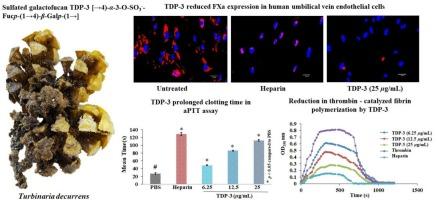Anticoagulant potential of sulfated galactofucan Turbinaria decurrens (Bory de Saint-Vincent, 1828) in human umbilical vein endothelial cells: A marine-derived approach to thrombotic disorder management
IF 4.5
2区 生物学
Q1 BIOTECHNOLOGY & APPLIED MICROBIOLOGY
Algal Research-Biomass Biofuels and Bioproducts
Pub Date : 2025-08-01
DOI:10.1016/j.algal.2025.104258
引用次数: 0
Abstract
Sulfated galactofucans from the Sargassaceae family are garnering increasing attention for their therapeutic potential, especially in the management of thrombotic disorders, which are major contributors to disease and mortality. While conventional anticoagulants are effective, their use is constrained by bleeding risks and adverse effects, prompting the search for safer alternatives. This study explores the anticoagulant potential of TDP-3, a sulfated galactofucan isolated from Turbinaria decurrens, with the proposed structure [→4)-3-O-SO3−-α-Fucp-(1 → 4)-β-Galp-(1→], in human umbilical vein endothelial cells (HUVECs). TDP-3 (25 μg/mL) significantly prolonged activated partial thromboplastin time (aPTT: 112.45 s) and prothrombin time (PT: 93.80 s), indicating its ability to interfere with both intrinsic as well as extrinsic coagulation pathways. TDP-3 effectively reduced thrombin production to 49 %, with a significant decrease of Factor Xa (FXa) expression (6.28-fold) and phospho-MARCKS (p-MARCKS) expression (84.1 %). Furthermore, TDP-3 inhibited thrombin-catalyzed fibrin polymerization by 79.19 % and reduced intracellular calcium mobilization by 33.65 %. The compound also demonstrated notable antiplatelet activity, reducing ADP-induced platelet aggregation to 82.9 %. TDP-3 consists mainly of α-(1 → 4)-linked fucose monomers connected to β-galactose, with sulfate groups at the 3-O position, forming a repeating chain. The superior anticoagulant potential of TDP-3 can be attributed to its electronegative sulfate and hydroxyl groups, which modulate physicochemical characteristics, including molecular polarizability and topological polar surface area favorably, thereby enhancing hydrogen bonding interactions with key receptors in coagulation pathways. These findings position TDP-3 as a promising natural anticoagulant with potential therapeutic applications for managing thrombotic disorders. Its potential as a functional food further contributes to the expanding field of marine-derived anticoagulants.

硫酸半乳藻多糖(Bory de Saint-Vincent, 1828)在人脐静脉内皮细胞中的抗凝潜力:一种源自海洋的血栓性疾病管理方法
来自马尾藻科的硫酸半乳藻因其治疗潜力而受到越来越多的关注,特别是在治疗血栓性疾病方面,这是导致疾病和死亡的主要原因。虽然传统抗凝剂是有效的,但它们的使用受到出血风险和副作用的限制,促使人们寻找更安全的替代品。本研究探讨了TDP-3在人脐静脉内皮细胞(HUVECs)中的抗凝潜能。TDP-3是一种从尾Turbinaria decurrens中分离的硫酸半乳糖岩藻聚糖,其结构为[→4)-3- o - so3−-α- fucp -(1→4)-β- galp -(1→)]。TDP-3 (25 μg/mL)显著延长活化的部分凝血活素时间(aPTT: 112.45 s)和凝血酶原时间(PT: 93.80 s),表明其能够干扰内源性和外源性凝血途径。TDP-3有效地将凝血酶的产量降低到49%,其中Xa因子(FXa)的表达显著降低(6.28倍),phospho-MARCKS (p-MARCKS)的表达显著降低(84.1%)。此外,TDP-3抑制凝血酶催化的纤维蛋白聚合79.19%,降低细胞内钙动员33.65%。该化合物还显示出显著的抗血小板活性,将adp诱导的血小板聚集率降低至82.9%。TDP-3主要由α-(1→4)连接的聚焦单体与β-半乳糖连接,在3-O位置有硫酸基,形成一个重复链。TDP-3优越的抗凝潜力可归因于其电负性硫酸盐和羟基,它们有利于调节物理化学特性,包括分子极化率和拓扑极性表面积,从而增强与凝血途径中关键受体的氢键相互作用。这些发现表明TDP-3是一种很有前途的天然抗凝剂,在治疗血栓性疾病方面具有潜在的治疗应用。其作为功能性食品的潜力进一步扩大了海洋来源抗凝血剂的领域。
本文章由计算机程序翻译,如有差异,请以英文原文为准。
求助全文
约1分钟内获得全文
求助全文
来源期刊

Algal Research-Biomass Biofuels and Bioproducts
BIOTECHNOLOGY & APPLIED MICROBIOLOGY-
CiteScore
9.40
自引率
7.80%
发文量
332
期刊介绍:
Algal Research is an international phycology journal covering all areas of emerging technologies in algae biology, biomass production, cultivation, harvesting, extraction, bioproducts, biorefinery, engineering, and econometrics. Algae is defined to include cyanobacteria, microalgae, and protists and symbionts of interest in biotechnology. The journal publishes original research and reviews for the following scope: algal biology, including but not exclusive to: phylogeny, biodiversity, molecular traits, metabolic regulation, and genetic engineering, algal cultivation, e.g. phototrophic systems, heterotrophic systems, and mixotrophic systems, algal harvesting and extraction systems, biotechnology to convert algal biomass and components into biofuels and bioproducts, e.g., nutraceuticals, pharmaceuticals, animal feed, plastics, etc. algal products and their economic assessment
 求助内容:
求助内容: 应助结果提醒方式:
应助结果提醒方式:


